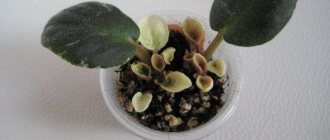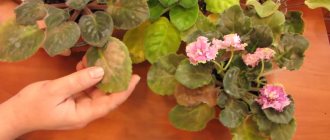Violets (Saintpaulias), like many indoor plants, are susceptible to various diseases and pests. It is fair to note that if all necessary preventive measures and appropriate care are observed, the risk of injury is minimized. And yet you should know what the most common diseases and pests of violets exist and what methods and means to combat them.
Violet disease - rot of leaves and roots and their treatment
Symptoms of this violet disease include:
- loss of leaf turgor;
- loss of the natural color of the rosette;
- wilting of petioles and leaf blades.
Latest articles about gardening
How to feed thuja in the summer? How to feed violets to bloom at home. How to feed violets?
Given the comprehensive nature of the violet disease, as in the photograph, treatment can only be urgent and drastic. Damaged tissue is removed, Saintpaulia is rooted using a healthy leaf that can produce new rosettes.
Very young rosettes, children and rooted leaves are susceptible to brown rot In the latter case, the stem at the base becomes brownish-brown, softens and thins. On the soil under the rosette, whitish threads of mycelium are found. And if urgent measures are not taken, the violet disease spreads to neighboring plants.
As a preventive measure, rooted plants are treated with a contact fungicide, not buried, and then the area under the stem is irrigated with phytosporin or a chemical similar in action.
Gray rot also leads to liquefaction and weakening of the green parts of the plant, while a gray fluffy coating is clearly visible on the affected surface. All leaves with signs of violet disease, as well as dead leaf blades and cuttings, are removed, preventing them from falling to the ground. To reduce the risk of infection during the cool season, it is extremely important:
- avoid excessive air humidity;
- stop spraying sockets;
- Water the violets correctly, avoiding stagnation of moisture and the formation of condensation.
Among the chemicals used to treat sockets and protect them, they choose fast and funda ash.
Causes of rotting of the root system (trunk) of violets.
The plant will look something like this. I didn’t have a suitable photo, so I took (temporarily) a photo from a friendly site - Fialki.ru.
But, let's first figure out why this happens? Why did the plant grow and grow and suddenly lose turgor? There may be several reasons, but they all lead to the same result - rotting of the root system and/or trunk.
The first case, in my opinion, is the most common among non-violet growers, rather, it happens among people who received these plants for the first time - these are very large pots. What happens when a violet is planted in a large pot? To understand this, you first need to understand how the root of this plant behaves in a pot?
It is enough to remove the plant from the pot, and we will see that all the roots are located along its walls. This suggests that in nature the roots of violets are located precisely in the upper layers of the soil and do not go deep into the ground. In a pot, the walls interfere with the roots, and the roots, of course, will tend to entwine the ball. But in order for the plant to have time to absorb all the moisture from the ground, the lump must also be of the appropriate volume. For already mature plants I use pots of 8 - 10 cm. In 10s I plant a plant with an already very well developed root system. And a generally accepted rule that will help you choose the right pot is that the diameter of the pot should be approximately three times smaller than the diameter of the rosette itself.
I often see photos on the website where children are growing in 10-12 cm pots, or even worse, leaves are waiting to take root. This cannot be done, the children have very small roots. They will not have time to absorb moisture, and all of it will remain in the ground. The soil will begin to turn sour. Air exchange will gradually be disrupted. The roots will begin to suffocate, followed by decay and loss of turgor. If the soil is heavy and not suitable for violets, the process will happen faster.
The second case is more likely seasonal - hypothermia of the earthen coma. This happens in the fall, when the temperature outside the window has already dropped, but the radiators have not yet been turned on, or in the spring, when the radiators are still working, but you already want to open the window. This case concerns flowers that stand on windows. Sometimes the windows are opened for ventilation. Cold air will cool the pot well after some time. Violets cannot tolerate hypothermia, and their delicate roots receive a kind of shock. The situation will get worse if the plant is watered in the evening. Here the volume is not so important, rather the material from which the pots themselves are made is important. The plastic will prevent the evaporation of moisture through the walls, thereby the cooling process will not proceed as quickly. Clay, on the contrary, will only contribute to this process. It's simple physics - water evaporating from a surface cools it. You don’t have to look far for an example; everyone came out of the river. Plastic has no pores, clay is a porous material, water passes freely through the pores. So, if you keep flowers in clay pots on your windows, keep an eye on the situation.
Third case. Well, there could be any background here. Either we don’t have time to water, or we forget to water. As a result, we get a dried out lump of earth. By this time, the plant has also most likely lost its turgor, and is standing “with drooping ears.” What does a person who is very far from such a situation do (this applies specifically to violets)? Of course, as he is used to, he runs to water the plant in order, as he thinks, to help it. And it waters well, so that the water flows into the pan and fills it almost completely. Here, drink! And he thinks that violet will drink in this situation. No, she most likely won’t drink anymore, because she has nothing to drink. The roots have dried out and lost their ability to deliver water to the leaves. They can only rot.
Now that we already have one of the three situations, let’s look at one mistake when replanting an already weakened plant. For several days now we have been looking at a plant that does not raise its leaves, we think that it will not drink, we try to water it more, but no, there is no turgor. It's time to remove the plant from the pot. This process cannot be delayed for long. We must also remember that the colder it is around, the faster the process of decay will occur. We take out the plant and shake off the soil. What do we see? The roots have become brown (or even black, this is when they are completely rotten), they break off easily. If we wash all this, we will see this picture:
Like in the commercial with split ends. The thinnest roots, which are precisely responsible for supply, begin to rot. There are still some fat ones left.
In this situation, it is best to cut off all the roots and strip the trunk to healthy tissue. Because now it’s completely impossible to see what’s wrong with the trunk. There may also be rot on it. If it remains, then the plant will not grow after transplantation, but will, as they say, “sick.” This is the main mistake of a person who is trying to solve this problem with a transplant. A transplanted plant with rotten roots (trunk) will not get rid of the disease itself, but will gradually rot in a new pot. So, cut off the roots and clean the trunk:
When I removed everything and cleaned the barrel, at first glance I liked everything. But my meticulousness in everything led me to the main thing. While picking out another (very tiny) crust on the trunk, I discovered a wormhole going deep into the trunk. She is in a red circle. It was also impossible to leave it, so I had to cut another trunk down to this hole. The rot there has already reached the center (unfortunately I didn’t take a photo). But everything was cleaned up, and the plant was successfully sent for rooting. It's already growing now.
Now let’s summarize: if turgor is lost, you cannot delay saving the plant. If there is no turgor for three days, remove it from the pot and perform the steps described above. I hope the article will be useful.
Powdery mildew on Saintpaulias and treatment
This is a disease of violet leaves, the causative agents are powdery mildew fungi - parasites. These fungi reproduce by spores and grow quickly in favorable conditions, therefore, with this disease, small white dots first appear on the leaves, which increase in size and can envelop, as if in a white cobweb, the entire surface of the leaf. A white coating may appear on the outside and inside of the leaves; flower buds may also be affected.
A favorable environment for the development of fungi is low temperature and high humidity. Young and newly transplanted plants are most susceptible to powdery mildew infection. Powdery mildew infection can occur: when watering, from an infected plant to a healthy one, fungal spores can be carried by insects or air currents.
Treatment of a flower for powdery mildew can be done either using ordinary sulfur or using antifungal drugs for violets. There are also many traditional medicines to combat powdery mildew - this is the treatment of plants with various solutions. You can prepare these solutions yourself: from soda ash with soap, whey, kefir, dry mustard, potassium permanganate, ash, mullein, infusion of horsetail, garlic, onion peels. To avoid the development of powdery mildew, it is necessary not to create favorable conditions for fungi.
Fucarium disease of violets and treatment
Signs: browning of petioles and falling leaves of violets.
Causes: This is a disease caused by a fungus of the genus Fusarium. From the soil, the fungus enters the roots of the plant and infects the vessels of all its parts - the stem, peduncles, leaf cuttings. These fungi release toxic substances that cause browning and rotting. It appears, like late blight, with excessive watering and cold. Its appearance is facilitated by sudden temperature changes, watering with cold water, and the heavy granulometric composition of the soil, which causes water to stagnate in it.
Treatment: the same treatment is used as for late blight. In addition to phytosporin, for preventive purposes, you can water the foundation with azole. To do this, dilute 1 gram of funda ash in 1 liter of water. Watering is carried out once every two months.
Infectious diseases of violets.
Infectious diseases of violets caused by fungi, viruses and bacteria are dangerous because they very quickly infect other plants if they are not eliminated in time. Let's consider common diseases of violets and pests that are most often found on these delicate flowers.
Rotting of the stem and root system.
Rotting of the stem and root system. The first sign of stem rotting is the wilting of the lower leaves. They become dull, as if dusty, as if the plant needs watering (although the earthen ball is quite moist). Rotting of the roots and stems of violets can be noticed during transplantation. The reasons may be planting in dense, heavy soil, a high concentration of fertilizers in the soil mixture, large pots, watering with cold water, insufficient air temperature (below 20 ° C), or planting plants too deep.
In adult specimens, the stems also rot when the soil is compacted and there is no free access of air to the roots. In this case, the part of the stem located in the ground rots, the roots grow only in the upper layer of the earthen ball (the earthen ball is very dense inside), the rosettes of leaves lose their decorativeness and stability in the soil. It is best to transplant them into fresh soil mixture. If this is not done, the stem rots and the plant dies.
Timely re-rooting of a diseased plant often saves it. For this operation to be successful, it is necessary to cut off the upper part of the plant as high as possible, where the vascular bundles are still healthy and not browned. But even the core of the stem, which is apparently undamaged, may already be infected with the fungus. To prevent the infection from spreading further, you need to add an antifungal drug to the water where the top of the plant takes root. Without re-rooting, treating violets with fungicides is ineffective. If leaves torn from a diseased plant do not take root or do not bear fruit for a long time, it means that they are already partially affected by an intravascular infection.
Late blight.
Late blight is a fungal disease. It enters the violet through microcracks in the leaves and through the roots. As a result, the root collar quickly begins to rot. The disease makes itself felt by brown spots on the leaves of plants, drooping leaves in wet soil. The development of the disease is promoted by hypothermia with insufficient lighting and excessive watering.
At the beginning of the disease, the flower can be saved. We tear off all damaged, limp leaves. We leave only those that have good turgor. With these infections, the roots partially or completely die and turn brown. We urgently remove the violet from the pot, remove the dead roots, or rather, they fall off on their own, while the roots do not hold the lump of earth, it falls apart in the hands, while in a healthy violet the lump is tightly held by white, healthy roots. Those roots that still cling to the violet are probably alive. We transplant the violet into sterile soil in a small pot (smaller than it was); the soil should contain a lot of perlite and vermiculite. Lightly water it with phytosporin and put it in the greenhouse, keep it there until it gets better and new leaves begin to grow. If all the roots are dead, cut them off with a sharp knife, make a transverse cut on the stem to the healthy tissue (diseased tissue is brown, healthy tissue is green). And we re-root the violet in vermiculite or in soil with a large addition of loosening substances in a greenhouse.
Rotting of the rosette (fusarium).
Rotting of the rosette (fusarium) is an infectious fungal disease caused by the fusarium fungus, which penetrates from the soil into young roots and affects the conducting vessels of the roots, stem, leaf petioles, and peduncles. Mushrooms secrete special toxin substances that cause browning and rotting. More often manifested in the cold season with excessive watering and excessively heavy soil, a pot that is too spacious, sudden temperature fluctuations, and watering with cold water. With fusarium, you will notice that the petioles of the leaves have turned brown and begun to fall off, and the affected areas die off. Upon inspection, you can see dark, rotting roots that are easily separated from the soil.
The violet disease develops intensively at low air temperatures (below 16 ° C), abundant watering, high humidity, excessive nitrogen fertilization, and poor air circulation.
Treatment: as for late blight. To prevent fusarium, water indoor plants once every two months with a solution of fundozol (1 g/l). Treat diseased violets with fungicides, removing rotten parts and dried flowers. And of course, try not to violate the rules for growing indoor violets.
Gray rot.
Gray rot, or botrytis, appears when watering is careless, especially when drops of water get on the leaves and petals, which quickly begin to turn brown and rot. Gradually, a fluffy, smoky-gray coating appears on the dead parts, the spots quickly increase, covering more and more new leaves, petioles and even growing points, which causes complete rotting and death of the plant.
It is necessary to immediately remove browned, affected leaves and treat the violet with foundationazole or another fungicide. There is only one way to prevent these diseases: in late autumn and winter, avoid excessive watering. A humid environment, changes in daily temperatures and lack of light are conditions for the development of soil pathogens and plant diseases.
Powdery mildew.
On indoor violets, you can often see a white coating on the stems, leaves and peduncles. Sometimes the leaves seem dusty, but no matter how much you wash them, the whitish spots do not disappear.
The appearance of these signs indicates that your plants are affected by powdery mildew. No matter how hard you try to prevent violet diseases, powdery mildew can appear at any time. Its spread is facilitated by lack of lighting (if violets are kept away from windows), low temperature with high air humidity, dust on plants and dirt on the shelves where pots of violets are located, excess nitrogen in the soil with a lack of potassium and phosphorus.
To get rid of powdery mildew, it is necessary to mainly use fungicides: topaz (at a concentration of 0.5-0.75 per 1 liter) - helps only in the early stages; saprol (0.1% solution) - also only in the early stages; bayleton (0.05-0.075% solution) - used in later stages of the disease, if the entire plant is already white. Not only sick plants are sprayed, but also neighboring healthy plants. If the result is not immediately noticeable, you can repeat the spraying after ten days. The basic rule is that medications must be alternated! An old recipe (in the early stages): dust the rosette with sulfur powder and place it under a plastic bag. There is an opinion that at temperatures above 25 degrees. sulfur vapors fight powdery mildew well. Sometimes you need to take care to reduce the nitrogen content. To do this, pour warm water (30 °C) over the earthen ball - approximately 0.3 liters per pot. Subsequently, they are fed with phosphorus and potassium fertilizers (1 g per 1 liter of water).
Violet leaf spot and treatment
Viral diseases can slow down the development of violets, change the appearance of the plates and stop flowering.
The causes of the spread of the disease may be the colonization of the flower by parasites. The bronzing virus is accompanied by the appearance of disfigured leaves, colored brownish.
Viral diseases cannot be treated, so the plant is destroyed.
Latest articles about gardening
Catharanthus: cultivation and care, photo Drip irrigation from bottles in a greenhouse Cabbage: planting seedlings timing
Late blight of Saintpaulia rosettes and treatment
A sign of late blight is brown, dry spots on the leaf part of the plant. The spots spread very quickly. In the shortest possible time, the plant tissue undergoes necrosis and the rosette withers.
If the top of the rosette is not damaged, then you can cut it off, treat it with a fungicide, cut off the damaged areas and root it. Individual leaves are also suitable for rooting.
The remaining part of the flower is destroyed. Neighboring flowers must be treated.
Bronze and violet leaf spot viruses and treatment
Viral diseases change the appearance of leaf blades, tissue supply and plant development. These diseases can be the reason why violets do not bloom at home, and then stop developing altogether.
The bronzing virus, for example, causes malformed leaves with discoloration. Such plants sometimes turn out to be unviable and are destroyed. And pests that are also found in apartments can spread the disease of violets. In this case it's thrips.
Common Causes
This is a list of factors that cause violet stalks, leaves, and flowers to rot:
- Saintpaulia is aging, age-related changes;
- excess fertilizing;
- waterlogging of the soil;
- moisture getting on the surface of the leaf plate and flowers;
- pot too big for the plant;
- incorrect soil: too alkaline or acidic;
- fungal diseases;
- damage to the integrity of the leaf surface by harmful insects.
Previously, we talked about caring for Saintpaulia.
Gray rot on violets and its treatment
Other indoor plants suffer from this fungal disease, not just Saintpaulia. The infection affects the tissue of young seedlings, leaves, flowers and buds. The plant turns brown, rots, or becomes covered with a gray-brown coating. The violet becomes covered with brown spots, which quickly spread throughout the plant. Typically, this type of parasite penetrates weakened plants through mechanical damage. In this case, you need to spray with a copper-soap solution (dilute 20 g of liquid potassium soap and 2 g of copper sulfate in 1 liter of water). In order to avoid infection, experts recommend carrying out preventive procedures. Feed with fertilizers and microelements, which significantly increase the plant’s resistance.
White coating on violet leaves
At first, the white coating may seem like a thick layer of dust. The leaves of the violet are textured in themselves, so at first it is not too visible whether there is a coating or cobwebs on them.
— An intense white coating is left by powdery mildew, one of the most common fungi on plants;
— A grayish coating on brown softened leaves is a symptom of gray rot or botrytis;
— Pale mucous plaque on hot summer days is a sign of vascular bacteriosis. It is urgent to establish ventilation and lower the air temperature;
—Large white flakes throughout the plant indicate the presence of mealybugs;
- A silvery coating that quickly darkens or turns red appears due to downy mildew.
Photo: sanpros.ru
Diseases of raspberry leaves: descriptions with photos, treatment
Caring for violets at home
Violet lighting
If you have a lot of windows, choose an area in your home that has the most indirect soft light. Violets should be placed on a southern windowsill with caution, as they do not like direct sunlight, so on a southern windowsill you need to shade them: cover the window to the height of the flowers' growth with curtains. If you spend a lot of time in the kitchen, you can also place flowerpots with Saintpaulias there. Firstly, their presence will make you feel comfortable, and secondly, violets like high humidity and good light in the kitchen.
If your house violets don't get enough light, they may look pale and lethargic. The leaves will stretch upward, the stalk will lengthen, which means the harmonious shape of the rosette will be disrupted.
Watering violets
I water my violet plants 1-2 times a week (depending on the season). I use soft, settled water at room temperature. Some novice Saintpaulia lovers water them, like other flowers, directly from above into the ground. But this must be done extremely carefully. Moisture should not get on the violet leaves, much less on the flower growth points. Stagnation of water on cuttings or leaves leads to their rotting. I prefer to water violets not in the ground, but by pouring water into a tray up to 2/3 of the height of the pot. Flower growers call this “bottom watering.” But under no circumstances should you leave water in the pan “in reserve.” Roots should breathe, not float! Therefore, 20-30 minutes after the soil is saturated with moisture, I drain the remaining water.
Violets cannot be sprayed, but they, like other flowers, love moist air. Therefore, place a container of clean water next to the flowerpots or place pieces of damp cloth or a wet sponge.
Latest articles about gardening
When to harvest spinach? Lantana: care at home Moles: how to deal with them?
Transplanting violets
Planting a flower will not be difficult even for a novice gardener. First you need to remove the plant from the pot. Then clean the roots from the old soil composition and look at them carefully. If sluggish, damaged or dry root shoots and leaves are found, it is recommended to remove them immediately. But do not rush to plant the plant after this.
The cut areas will need to be treated with activated carbon, ground into powder. Remember: if a significant part of the root system has been cut off, it is advisable to transplant the flower into a smaller flowerpot. Now all you have to do is fill the pot with a layer of drainage, soil mixture, and then place the houseplant there.
As for the classic method of planting violets with a leaf blade, everything is quite simple. But there is another common method - transshipment. It is often used when a flower needs to be saved from disease. That is, you will not need to completely clear the Saintpaulia root system from the soil.
When planting, you only partially update the soil composition. If the old blooming violet is planted according to all the rules, you will soon see how much better it begins to bloom. Take care of your pet and you will be satisfied with the result. Let the violet bloom throughout the year, and caring for it will not become a burdensome task for you.
Main growing problems
Despite the fact that Saintpaulia is less demanding on conditions, there are certain nuances in caring for it. Therefore, when growing violets, many gardeners are often familiar with such problems as:
- leaf spotting and deformation,
- loss of turgor and dryness of leaf blades,
- the appearance of rot on rosettes and roots.
More often, the causes of unpleasant manifestations lie in errors during care:
- incorrect choice of place for a flower with insufficient or excessive lighting,
- incorrect watering mode,
- too high or low humidity in the room,
- improper application of fertilizers and fertilizing.
If you correct the shortcomings in care, the drooping plant will turn into a healthy blooming violet. When optimizing the conditions for keeping Saintpaulia does not improve the situation, it means that the source of the problem lies in the development of the disease or the natural processes of the plant.











